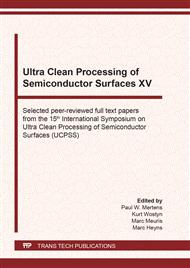p.222
p.228
p.237
p.247
p.253
p.259
p.264
p.270
p.277
Nodule Deformation of PVA Roller Brushes on a Rotating Plate: Optimum Cleaning for Nanosized Particles due to Liquid Absorption and Desorption of Sponge Deformation
Abstract:
It is very difficult to remove extremely small particles from the surface of the wafer. Here, we proposed a new cleaning strategy using brush scrubbing, namely, nodule deformation induced fluid flow. Liquid absorption and desorption due to brush deformation enhance the mixing of liquids containing small particles. In this study, we developed a setup that reproduced the actual movement of PVA roller brushes on a rotating wafer and observed the contact surface of the brush nodule. We modeled the brush nodule deformation for each rotating condition. As a result, three types of nodule deformation were observed. In most cases, the nodule side face, rather than the bottom face was mainly in contact with the wafer surface. Moreover, we compared two types of roller brushes, normal cylindrical nodules, and edge treated nodules and found that the deformation can be significantly changed by chamfering nodule edge.
Info:
Periodical:
Pages:
253-258
Citation:
Online since:
February 2021
Keywords:
Price:
Сopyright:
© 2021 Trans Tech Publications Ltd. All Rights Reserved
Share:
Citation:


